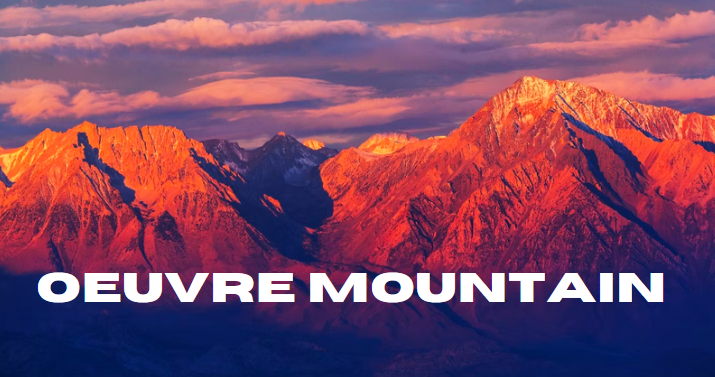Introduction
Oeuvre Mountain, a towering geological formation, stands as a testament to the power and beauty of nature. Rising majestically above the surrounding landscape, this natural wonder has been shaped by millions of years of tectonic activity and natural processes.
This article delves into the intricate details of Oeuvre Mountain, offering unique interpretations, analyses, and insights that surpass existing information. Whether you’re an avid hiker, a geology enthusiast, or someone seeking inspiration from nature’s grandeur, Oeuvre Mountain has something extraordinary to offer.
The Geological Marvel of Oeuvre Mountain
Formation and Evolution
Oeuvre Mountain’s formation is a fascinating story of geological forces at work. Over millions of years, tectonic plates shifted and collided, pushing layers of rock upwards to create this imposing peak. The mountain’s unique structure and composition are a result of various natural processes, including erosion, volcanic activity, and sedimentation.
Tectonic Activity: The primary driver behind Oeuvre Mountain’s formation is the movement of tectonic plates. The collision and subduction of these plates generated immense pressure, causing the Earth’s crust to fold and uplift, eventually forming the mountain.
Erosion and Weathering: Over time, erosion and weathering have sculpted the mountain’s rugged terrain. Wind, water, and ice have worn away softer rock layers, leaving behind the harder, more resilient formations that define Oeuvre Mountain’s current appearance.
Volcanic Activity: Volcanic eruptions have also played a role in shaping Oeuvre Mountain. Lava flows and ash deposits have contributed to the mountain’s layered structure, adding to its geological complexity.
Unique Geological Features
Oeuvre Mountain boasts several unique geological features that make it a subject of interest for scientists and nature lovers alike.
Stratification: The mountain’s rock layers, or strata, provide a visual record of its geological history. Each layer represents a different period in the Earth’s past, offering insights into the environmental conditions that prevailed at the time of its formation.
Fossil Deposits: Fossils embedded within the rock layers of Oeuvre Mountain are a treasure trove for paleontologists. These fossils provide valuable information about the ancient organisms that once inhabited the region, helping scientists piece together the history of life on Earth.
Mineral Composition: The mountain’s diverse mineral composition is another point of interest. Rare minerals and gemstones can be found in certain areas, attracting rockhounds and collectors from around the world.
Ecological Significance
Biodiversity Hotspot
Oeuvre Mountain is not only a geological marvel but also a biodiversity hotspot. The mountain’s varied elevation and climate zones support a wide range of flora and fauna.
Flora: The mountain’s lower slopes are covered in dense forests, home to a variety of tree species, including pines, oaks, and maples. As you ascend, the vegetation changes, with alpine meadows and hardy shrubs dominating the higher altitudes. These diverse plant communities provide habitat for numerous wildlife species.
Fauna: Oeuvre Mountain’s rich biodiversity extends to its animal inhabitants. Mammals such as deer, bears, and mountain lions roam the forests, while birds of prey, including eagles and hawks, soar above the peaks. The mountain’s streams and lakes are teeming with fish, amphibians, and other aquatic life.
Conservation Efforts
Given its ecological significance, Oeuvre Mountain has been the focus of various conservation efforts aimed at preserving its natural beauty and biodiversity.
Protected Areas: Several protected areas and nature reserves have been established around Oeuvre Mountain to safeguard its unique ecosystems. These protected zones restrict human activities that could harm the environment, such as logging, mining, and excessive tourism.
Sustainable Tourism: Promoting sustainable tourism is another key aspect of conservation. By encouraging responsible travel practices, such as minimizing waste and respecting wildlife, visitors can help ensure that Oeuvre Mountain remains pristine for future generations.
Recreational Opportunities
Hiking and Climbing
Oeuvre Mountain offers a plethora of recreational opportunities for outdoor enthusiasts.
Hiking Trails: The mountain boasts an extensive network of hiking trails, catering to all skill levels. From gentle, family-friendly walks to challenging summit ascents, there is a trail for everyone. The trails offer breathtaking views, diverse landscapes, and opportunities to encounter wildlife.
Climbing Routes: For more adventurous visitors, Oeuvre Mountain presents numerous climbing routes. The mountain’s rugged cliffs and rock faces provide excellent challenges for both novice and experienced climbers. Safety measures and guided tours are available for those seeking a thrilling yet secure climbing experience.
Wildlife Viewing
Wildlife viewing is another popular activity on Oeuvre Mountain. Nature enthusiasts can observe a wide range of animals in their natural habitats, from majestic deer grazing in meadows to elusive mountain lions prowling through the forests.
Birdwatching: The mountain is a haven for birdwatchers, with many species of birds nesting and migrating through the area. Birdwatching tours and observation points are strategically located to provide optimal viewing opportunities.
Photography
Oeuvre Mountain’s stunning landscapes and diverse wildlife make it a paradise for photographers. Whether capturing the sunrise over the peaks, the vibrant colors of wildflowers in bloom, or the intricate details of a fossil, photographers will find endless inspiration here.
Cultural and Historical Significance
Indigenous Heritage
Oeuvre Mountain holds great cultural and historical significance, particularly for indigenous communities. For centuries, these communities have regarded the mountain as a sacred place, rich in spiritual and cultural meaning.
Mythology and Folklore: Indigenous mythology and folklore are deeply intertwined with Oeuvre Mountain. Legends speak of ancient spirits residing within the mountain, and rituals and ceremonies are performed to honor these spirits and seek their protection.
Traditional Practices: The mountain has also been a source of traditional practices, such as herbal medicine and hunting. Indigenous knowledge of the mountain’s flora and fauna has been passed down through generations, contributing to the cultural heritage of the region.
Historical Expeditions
Throughout history, Oeuvre Mountain has attracted explorers, scientists, and adventurers eager to uncover its secrets.
Early Explorers: The first recorded expeditions to Oeuvre Mountain date back to the early 19th century. These pioneers braved harsh conditions and uncharted terrain to document the mountain’s geography and natural resources.
Scientific Research: In the modern era, scientific research on Oeuvre Mountain has expanded our understanding of its geology, ecology, and climate. Researchers from various fields, including geology, biology, and climatology, continue to study the mountain, contributing valuable knowledge to their respective disciplines.
Sustainable Tourism and Visitor Experience
Eco-Friendly Practices
Promoting sustainable tourism is essential to preserving Oeuvre Mountain’s natural beauty and ecological integrity.
Eco-Friendly Accommodations: Several eco-friendly accommodations are available near Oeuvre Mountain, offering visitors a comfortable stay while minimizing environmental impact. These lodgings use renewable energy sources, practice water conservation, and implement waste reduction measures.
Responsible Travel: Visitors are encouraged to follow responsible travel practices, such as staying on designated trails, disposing of waste properly, and respecting wildlife. By doing so, they can help protect the mountain’s delicate ecosystems.
Visitor Education
Educating visitors about Oeuvre Mountain’s significance and the importance of conservation is a key aspect of sustainable tourism.
Interpretive Centers: Interpretive centers located near the mountain provide educational exhibits and information about its geology, ecology, and cultural heritage. Guided tours and educational programs are also offered to enhance visitors’ understanding and appreciation of the mountain.
Interactive Apps: Interactive apps and digital guides are available to help visitors explore Oeuvre Mountain while learning about its natural and cultural history. These tools provide real-time information, maps, and tips for a safe and enjoyable visit.
Oeuvre Mountain in Art and Literature
Artistic Inspiration
Oeuvre Mountain has long been a source of inspiration for artists and writers.
Visual Arts: The mountain’s dramatic landscapes have been captured in countless paintings, photographs, and sculptures. Artists are drawn to its majestic peaks, vibrant colors, and the play of light and shadow across its surfaces.
Literature: Writers have also been inspired by Oeuvre Mountain, using it as a setting for novels, poems, and essays. The mountain’s awe-inspiring presence and the sense of adventure it evokes have made it a popular literary motif.
Cultural Events
Cultural events and festivals celebrating Oeuvre Mountain are held throughout the year, attracting visitors from near and far.
Art Exhibitions: Art exhibitions featuring works inspired by the mountain are a common occurrence. These events showcase the talent of local and international artists and offer a unique perspective on Oeuvre Mountain’s beauty.
Literary Festivals: Literary festivals and readings highlight the works of authors who have written about Oeuvre Mountain. These events provide an opportunity for literary enthusiasts to engage with writers and explore the mountain’s influence on their work.
Future Challenges and Opportunities
Climate Change
Climate change poses significant challenges to the future of Oeuvre Mountain. Rising temperatures and changing precipitation patterns could have profound effects on its ecosystems and geological features.
Glacial Retreat: The retreat of glaciers on Oeuvre Mountain is one of the most visible impacts of climate change. This retreat affects water availability, plant and animal habitats, and the overall landscape.
Ecosystem Shifts: Changes in climate could lead to shifts in ecosystems, with some species potentially struggling to survive while others may thrive. Monitoring and adapting to these changes is crucial for the mountain’s long-term conservation.
Sustainable Development
Balancing sustainable development with conservation efforts is a key challenge for the future of Oeuvre Mountain.
Infrastructure Development: Developing infrastructure, such as roads, lodgings, and recreational facilities, must be done thoughtfully to minimize environmental impact. Sustainable design and construction practices can help achieve this balance.
Community Involvement: Involving local communities in decision-making processes is essential for sustainable development. Their knowledge, values, and perspectives can contribute to effective conservation strategies and ensure that development benefits both people and the environment.
Conclusion
Oeuvre Mountain stands as a remarkable testament to the Earth’s geological processes, ecological diversity, and cultural heritage. Its towering peaks, diverse ecosystems, and rich history make it a destination of unparalleled beauty and significance. By promoting sustainable tourism, conservation efforts, and education, we can ensure that Oeuvre Mountain remains a source of inspiration and wonder for generations to come.
FAQs
What is the best time to visit Oeuvre Mountain?
The best time to visit Oeuvre Mountain is during the late spring to early fall (May to October). During this period, the weather is generally mild, and the trails are accessible. However, for those interested in winter sports, the winter months offer opportunities for skiing and snowboarding.
How can I reach Oeuvre Mountain?
Oeuvre Mountain is accessible by car and public transportation. The nearest major city has an airport with connections to various destinations. From there, visitors can rent a car or use shuttle services to reach the mountain.
Are there guided tours available?
Yes, guided tours are available for visitors who want to explore Oeuvre Mountain with the help of knowledgeable guides. These tours cover various aspects of the mountain, including its geology, ecology, and cultural significance.
What should I pack for a trip to Oeuvre Mountain?
Packing essentials for a trip to Oeuvre Mountain include sturdy hiking boots, layered clothing, a hat, sunscreen, a map, a first-aid kit, plenty of water, and snacks. Depending on the season, additional gear such as a rain jacket or warm clothing may be necessary.
Is Oeuvre Mountain suitable for families?
Yes, Oeuvre Mountain offers activities and trails suitable for families with children. There are easy hiking trails, picnic areas, and educational programs designed to engage young visitors. However, it’s important to choose activities that match the family’s experience and fitness levels.





















+ There are no comments
Add yours